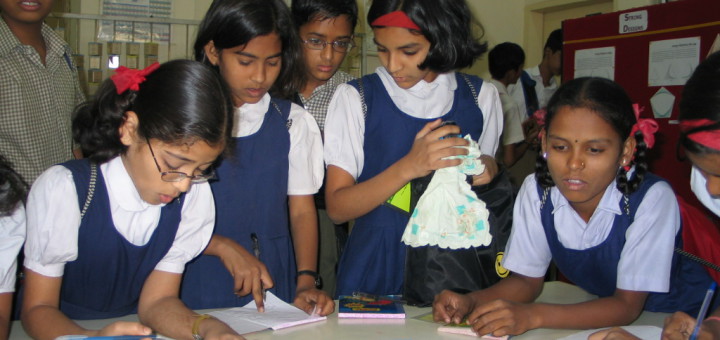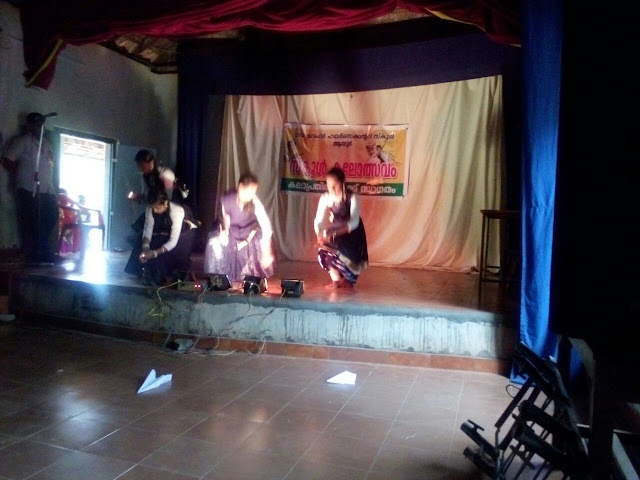Third week of our teaching practice was successfully completed. At Monday, no speciality, we took classes on the basis of school time table. At Tuesday, Sreedevi miss and chithra miss came to the school and observed the classes of natural science and social science students respectively. Our mathematics teacher Mrs Indhulekha visited the school and observed our classes. We completed our class with regular time table. At Thursday, our principal Mr Bhrahmanandhan visited our school, not for class observation. And also Mrs Indhulekha, the head of mathematics department visited the school for class observation. Last day, ie. Friday, no speciality, we completed the day with regular time table.
Tuesday, 29 November 2016
14/11/2016 - 18/11/2016
On this week, all the teacher trainees reached the school at proper time and signed the attendance register. All of us took classes according to their time table. We also got substitution classes. And we conducted unit in 8th and 9th standard. We the student of teacher trainees brought the school students to play-ground during the PT hour taught them various games and asked them to play. And also we serve the meal for students.
Monday, 28 November 2016
7/11/2016 - 11/11/2016
On this week, we all of us followed the regular time table of the school. We reached the school at the regular time and signed the attendance register. We attentively completed the class time tables. Every teacher trainees went the required substitution period at different classes.During the cultural period we conducted some recreational activities for students. And some teachers including me took special classes at their own class. Every day we serve the food for students. Every teacher trainees helped to line the students evening for keeping the discipline.
Thursday, 24 November 2016
TEACHING PHASE 2; DAY : THURSDAY - FRIDAY ; DATE : 3/11/2016 - 4/11/2016
REFLECTION ON SCHOOL EXPERIENCE
As a part of B.Ed curriculum, our second phase teaching practice started on 3/11/2016 at Jawahar H S, Ayur. Teacher trainees are :
Mathematics
5. Athulya R
6. Arya S
7. Ajanya J S
Natural science
1. Remya M
2. Saranya S
Social science
3. Vidhya V Nair
4. Vidhya Sekhar
First day all teacher trainees reached at 9.15 am itself and met the headmaster Mr. Rajendran. With the permission of our headmaster we met our concern teachers and they gave the time table and concerned classes. All the teacher trainees got 8th and 9th standards for teaching. On the basis, all teacher trainees were given substitution classes every day. On 4/11/2016 usual we followed the same time table of the school. Everyday lunch were given to students and we served the noon meal for them. Every teacher trainees went to the required substitution period to different classes. In this weak of teaching practice session every teacher trainees does not attended their own concern classes. Every day school dispersed at 4.00 pm. Every teacher trainees helped to line up the student at evening for keeping the school discipline and we also left the school to home.
TEACHING PHASE 1: DATE : 22/06/2016 - 30/08/2016
* We completed 40 lesson templates during these periods.
* For effective teaching we took ICT lesson in classrooms.
* For a change from normal classroom, we followed different models of teaching such as concept attainment model, inquiry training model, constructivist model.
* We conducted a school based activity at the smart classroom, on the topic of "chingam 1- farmers day".
* To make awareness in students about domestic waste management, we conducted a field study.
* After the completion of the 15 lesson template we conducted a diagnostic test to students for identify their difficulty levela. After the first, we gave appropriate remedial measures.
* To assess the achievement of the students through our teaching, we conducted an achievement test based on our lesson templates.
* We completed our practical and practicum works during that days , with the help of teachers and students.
*We provide physical education training based on our lesson template.
Friday, 18 November 2016
Tuesday, 15 November 2016
Wednesday, 10 February 2016
Beautiful Examples of Mathematics in Nature


- A nautilus is a cephalopod mollusk with a spiral shell and numerous short tentacles around its mouth.
- Although more common in plants, some animals, like the nautilus, showcase Fibonacci numbers. A nautilus shell is grown in a Fibonacci spiral. The spiral occurs as the shell grows outwards and tries to maintain its proportional shape.

- The number of steps will almost always match a pair of consecutive Fibonacci numbers. For example, a three–to–five cone meets at the back after three steps along the left spiral and five steps along the right.

- Honeycombs are an example of wallpaper symmetry. This is where a pattern is repeated until it covers a plane. Other examples include mosaics and tiled floors.
- Mathematicians believe bees build these hexagonal constructions because it is the shape most efficient for storing the largest possible amount of honey while using the least amount of wax. Shapes like circles would leave gaps between the cells because they don’t fit perfectly together.
- Using this new information, scientists have become more confident in their theory that the galaxy has only two major arms: the Scutum-Centaurus and the Perseus.
- As well as having mirror symmetry, the Milky Way has another amazing design. Like nautilus shells and sunflowers, each ‘arm’ of the galaxy symbolises a logarithmic spiral that begins at the galaxy’s centre and expands outwards.

- Most animals have bilateral symmetry, which means drawing an even centre line would create two matching halves.
- The peacock takes the earlier principle of using symmetry to attract a mate to the nth degree. In fact, Charles Darwin, who famously conceived the survival of the fittest theory, detested peacocks.
- Darwin thought the peacock’s tail was a burden that made no evolutionary sense. He remained furious until coming up with the theory of sexual selection, which asserts that animals develop certain features to increase their chances of mating. Male peacocks utilise their variety of adaptations to seduce sultry peahens. These include bright colours, a large size, a symmetrical body shape and repeated patterns in their feathers.

- The sun has a diameter of 1.4 million kilometres, while his sister, the Moon, has a meagre diameter of 3,474 kilometres. With these figures, it seems near impossible that the moon can block the sun’s light and give us around five solar eclipses every two years. By sheer coincidence, the sun’s width is roughly four hundred times larger than that of the moon, while the sun is about four hundred times further away. The symmetry in this ratio causes the moon and sun to appear almost the same size when seen from Earth, and, therefore, it becomes possible for the moon to block the sun when the two align.
- Earth’s distance from the sun can increase during its orbit. If an eclipse occurs during this time, we see what’s known as an annular or ‘ring’ eclipse. This is because the sun isn’t completely hidden.
- Every one to two years, though, the sun and moon become perfectly aligned, and we can witness a rare event called a total solar eclipse.
- Astronomers don’t know how common this symmetry is between other planets, suns, and moons, but theorise that it’s quite rare. Every year, though, our moon drifts roughly four centimetres further from Earth. This means that, billions of years ago, every solar eclipse would have been a total eclipse.
- If things continue as they are, total eclipses will eventually cease entirely – as will annular eclipses, assuming the planet lasts that long. With this in mind, it’s easy to conclude that we’re simply in the right place at the right time to witness this phenomenon. Some have theorised that this sun-moon symmetry is the special factor which makes life on Earth possible.

- Starfish or sea stars belong to a phylum of marine creatures called echinoderm. Other notable echinoderm include sea urchins, brittle stars, sea cucumbers and sand dollars.
- The larvae of echinoderms have bilateral symmetry, meaning the organism’s left and ride side form a mirror image. However, during metamorphosis, this is replaced with a superficial radial symmetry, where the organism can be divided into similar halves by passing a plane at any angle along a central axis.
- Sea stars or starfish are invertebrates that typically have five or more ‘arms’. These radiate from an indistinct disk and form something known as pentaradial symmetry.
- Their evolutionary ancestors are believed to have had bilateral symmetry, and sea stars do exhibit some superficial remnant of this body structure.
10. Orb Web Spiders
- There are approximately 5,000 types of orb web spiders. All of them create near-perfect circular webs that have near-equal-distanced radial supports coming out of the middle and a spiral that is woven to catch prey.
- It’s not clear why orb spiders are so geometrically inclined. Tests have shown that orbed webs are no better at catching prey than irregularly shaped webs.
- Some scientists theorise that orb webs are built for strength, with radial symmetry helping to evenly distribute the force of impact when a spider’s prey makes contact with the web. This would mean there’d be less rips in the thread.
Mathematics Laboratory

Wednesday, 20 January 2016
Mathematics is a very important subject. The term mathematics may be defined in a number of ways. It is a exact science which is related to measurements, calculations, discovering relationships and dealing with the problems of space.
DIFFERENT QUOTES RELATED TO MATHEMATICS
- " Mathematics is the indispensable instrument of all physical researches". - Kant
- "Mathematics is the queen of sciences and arithmetic is the queen of all mathematics". - Gauss
- "Mathematics is the gateway and key to all sciences". - Bacon
- "Mathematics is the science of indirect measurement". - Comets
- "Mathematics is the language in which god has written the universe".- Galileo
- "Mathematics is the study of quantity". - Aristotle
Wednesday, 6 January 2016
TORUS
An torus is a surface having genus one, and therefore possessing a single "hole" . The single-holed "ring" torus is known in older literature as an "anchor ring." It can be constructed from a rectangle by gluing both pairs of opposite edges together with no twists . The usual torus embedded in three-dimensional space is shaped like a donut, but the concept of the torus is extremely useful in higher dimensional space as well.
































